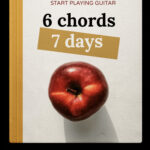Guitar tablature, most commonly known as “guitar tabs,” is a revolutionary system for writing music that empowers aspiring guitarists, especially beginners, to dive into playing their favorite songs swiftly and effortlessly. Similar to traditional music notation, guitar tabs provide a roadmap of musical notes, rhythm, and playing techniques. However, guitar tabs have a distinct advantage, particularly for guitarists: they visually represent where to place your fingers on the fretboard to play specific notes.
This is incredibly beneficial because, unlike many other instruments, the guitar allows you to play the same note in multiple positions across the fretboard. Understanding guitar tablature and learning How To Read Guitar Tabs Sheet Music unlocks the door for beginners to start playing without the initial hurdle of mastering standard musical notation.
At guitarplayers.net, we recognize the power of guitar tabs as an accessible and engaging way to learn. Guitar tabs effectively display both chords and single notes, making them an accelerated pathway to learning songs you love. The beauty of learning how to read guitar tabs lies in its simplicity; it doesn’t demand prior musical knowledge beyond identifying strings and frets on your guitar.
If you’re excited to discover the world of guitar tabs and understand how they can transform your learning journey, you’ve landed in the perfect spot. Let’s embark on this musical adventure together!
What are Guitar Tabs?
Guitar tablature is essentially a visual language for guitar music. Imagine it as a direct representation of your guitar strings and frets on paper. A standard guitar tab consists of six horizontal lines, each dedicated to representing one of the six strings of a guitar. When you learn how to read guitar tabs, you’ll read them from top to bottom, with the top line representing the high E string (the thinnest string) and the subsequent lines representing the B, G, D, A, and low E strings (the thickest string).
This arrangement mirrors how you see the strings when you look down at your guitar in playing position. Think of guitar tablature as your personal musical map, guiding you on the quickest route to playing your favorite guitar tunes.
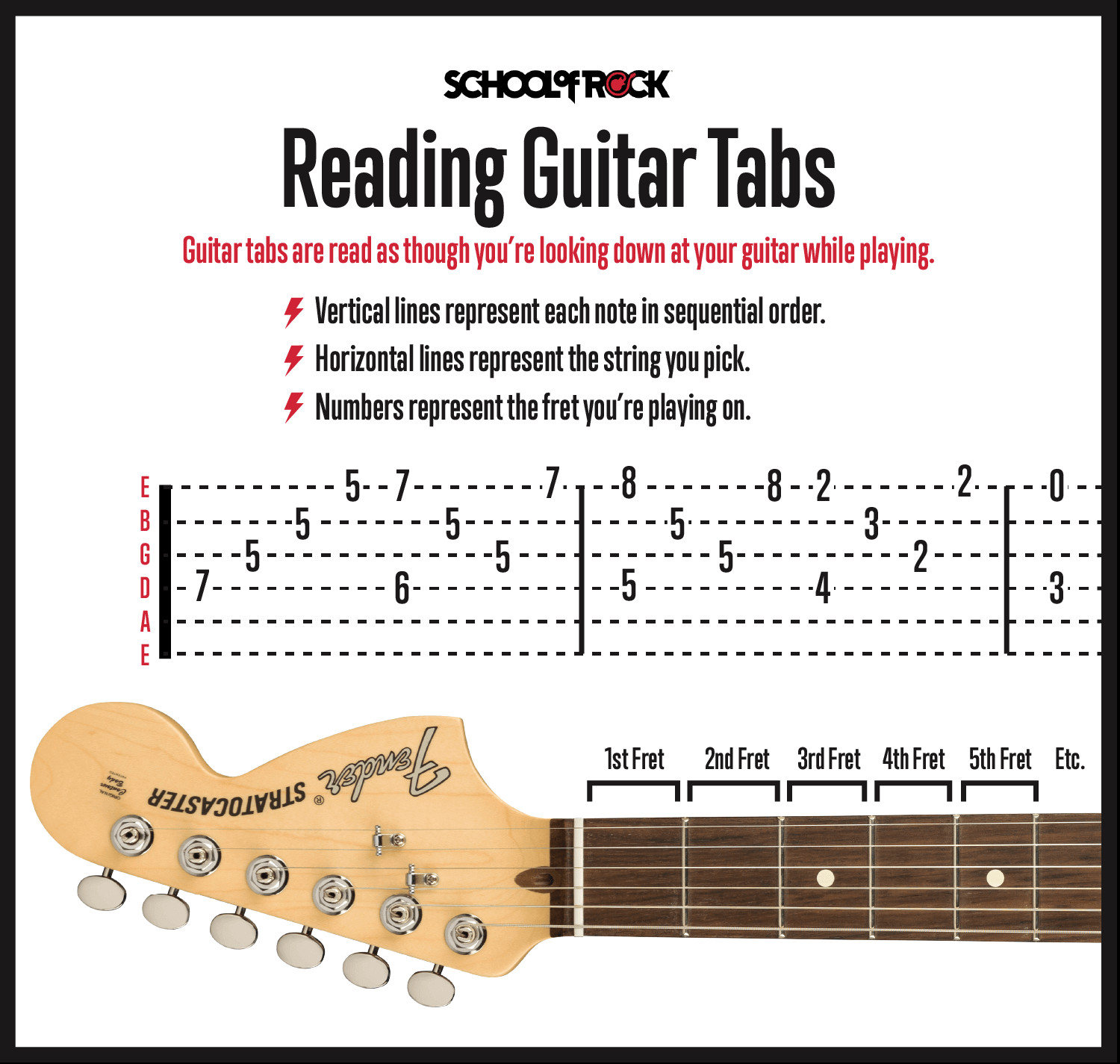 Reading guitar tabs
Reading guitar tabs
Alt text: A diagram illustrating how to read guitar tabs, showing the six horizontal lines representing guitar strings and numbers indicating frets.
Within guitar tablature, you’ll notice numbers placed on each of these lines. These numbers are your fret indicators. They correspond to the frets on your guitar – the thin metal strips running perpendicular to the strings along the fretboard. Frets are numbered starting from 0 at the nut (closest to the headstock) up to 24 (or more on some guitars), extending along the guitar neck.
A “0” on a string line signifies playing that string “open,” meaning you pluck or pick the string without pressing down any fret with your fretting hand. A “1” indicates playing the note at the first fret, “2” at the second fret, and so forth. As you learn how to read guitar tabs sheet music, remember that these numbers are direct fret references: 1 is the first fret, 2 is the second, 3 is the third, and so on, making it incredibly intuitive for beginners.
How to Read Guitar Tabs: Step-by-Step
Reading guitar tablature is a straightforward process, moving from left to right, just like reading words on a page. The notes in a tab are presented in the order they appear in the music. When you see numbers stacked vertically on top of each other, they represent a chord. A chord is played by strumming all the indicated strings together at the same time. Guitar tab notation is exceptionally beginner-friendly because it clearly shows you which notes to play to form a chord and, crucially, where to find those notes on your guitar fretboard.
What Do I Need to Know to Read Guitar Tabs?
For beginners to successfully learn how to read guitar tabs, familiarity with the six guitar strings and the layout of the frets is essential. This basic knowledge allows you to translate the tab symbols into finger positions on your guitar, effectively using the tab as your personal guide to playing music.
Understanding the Guitar Tab Staff
The guitar tab staff might look a bit like the staff used in standard music notation, but there’s a fundamental difference. In guitar tabs, the lines represent the 6 guitar strings themselves, not musical pitches as in standard notation.
The topmost line always corresponds to the high E string, and the bottom line to the low E string. This direct string representation is what makes learning how to read guitar tabs so accessible for beginners. To further avoid confusion with standard notation, a guitar tab staff is usually clearly labeled “TAB.”
Understanding Guitar Frets
Guitar frets are those essential metal strips embedded in your guitar’s fretboard.
Most guitars come equipped with anywhere from 19 to 24 frets. Each fret represents a single note, or a half step (also known as a semitone) in musical distance, from the adjacent fret. Within each octave, there are 12 notes (or frets). To help navigate these frets, most guitars feature fret markers – visual aids typically dots or inlays – positioned on the side of the neck or directly on the fretboard itself. These markers are commonly found at the 3rd, 5th, 7th, 9th, and 12th frets, making it easier to quickly identify fret positions while playing.
Remember this key point when reading guitar tabs: numbers indicate fretted strings, while the number “0” signifies an open string. An open string is played simply by picking or plucking it without pressing down on any fret.
Understanding Guitar Tab Chords
Guitar tabs don’t use special symbols to denote chords, but chords are easily recognizable by their layout in the tab. When multiple numbers are aligned vertically, directly above and below each other, they indicate notes that are played simultaneously, forming a chord. If a chord is arpeggiated – meaning the notes of the chord are played individually rather than all at once – the tab will show the notes in sequence, even though they are part of a chord shape.
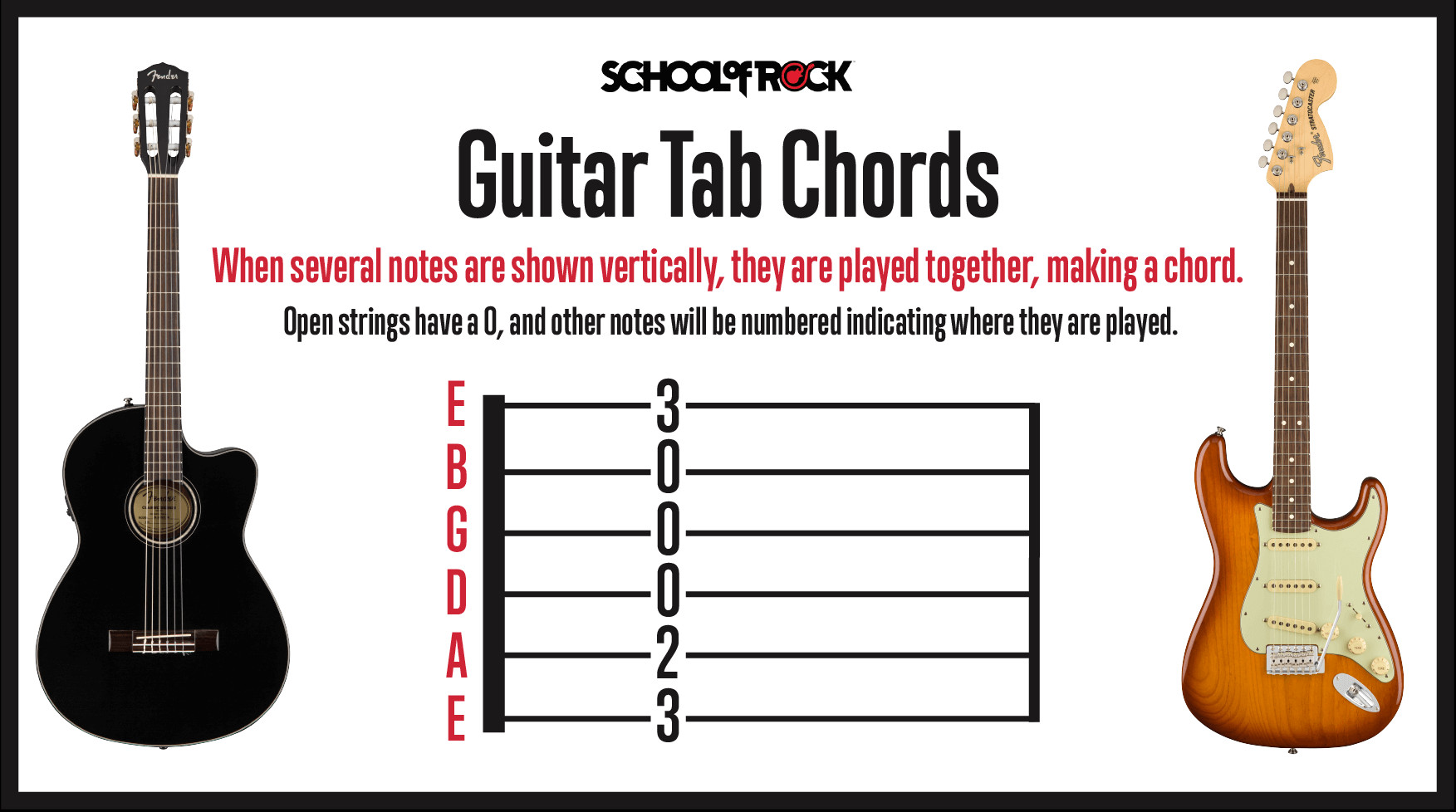 How to read guitar tab chords
How to read guitar tab chords
Alt text: An example of guitar tab chords, showing vertically aligned numbers on different strings that represent a chord to be strummed.
Understanding Guitar Tab Riffs
Riffs, the catchy and often repeated musical phrases, are the backbone of many rock and popular songs. Riffs typically combine single notes and partial chords, such as power chords. When reading guitar tabs for riffs, the same fundamental rule applies: vertically aligned notes are played together. This consistency makes learning how to read guitar tabs sheet music for riffs fast and intuitive.
Guitar Tabs vs. Chord Charts
Guitar tabs and chord charts serve different but complementary purposes. A chord chart is a visual diagram that illustrates where to place your fingers on the fretboard to form a specific chord. It often includes finger numbers to guide your fretting hand. Chord charts are frequently included alongside lyrics, placed above the words where chord changes occur in a song.
However, chord charts usually only depict the essential 3 to 4 notes that constitute a basic chord. A full and accurate musical arrangement might include single notes, notes outside the basic chord, or arpeggios – patterns of playing individual notes within a chord – which chord charts don’t typically show. For this reason, guitar tabs and chord charts often work together; chord charts provide a simplified view for beginners to grasp basic accompaniment, while guitar tabs offer a more detailed and complete musical picture.
Understanding Fingers and Numbers in Chord Charts
Chord charts, being visual representations of the fretboard, use a numbering system to indicate which fingers of your fretting hand should be used to play each note of a chord. The fingers are numbered as follows: index finger (1), middle finger (2), ring finger (3), and pinky finger (4).
This is distinct from guitar tabs, where numbers indicate frets, not fingers. Therefore, when you see chord charts alongside guitar tabs, the finger numbers in the chord chart help beginners learn proper hand positioning for chords, while the tab provides the detailed musical notation.
Guitar Tab Symbols and Techniques
Beyond lines and numbers, guitar tabs use a variety of symbols to indicate specific playing techniques. Learning to recognize and apply these symbols is crucial for making your guitar playing sound authentic and for fully understanding the nuances of guitar tabs.
Before you start playing, always ensure your guitar is properly tuned. Correct guitar tuning is essential for your guitar to sound right and for the tab to be accurate.
Muting Guitar Notes
Muting is a vital technique in many genres of guitar music, especially rock, metal, punk, and alternative. Muting adds rhythmic and sonic texture, giving music a distinct character.
How to Mute Guitar Notes
Muting can be achieved using either your picking hand, your fretting hand, or a combination of both. It’s a subtle technique that adds dynamics and polish to your playing. In many songs, you might find muted verses contrasting with unmuted choruses or hooks.
Experienced guitarists often incorporate muting instinctively without consciously thinking about it, especially when playing at amplified volumes. Muting is essential for controlling unwanted string noise and preventing feedback on stage or in practice.
Guitar Technique: Palm Muting (P.M.)
Palm muting is one of the most frequently used muting techniques in rock guitar. It involves resting the palm of your picking hand lightly on the strings near the bridge as you pick. Applying heavier palm muting creates a tight, percussive, rhythmic sound, while lighter palm muting allows notes to ring out with a muted character. In guitar tabs, palm muting is indicated by “P.M.” written above the section of the tab where it should be applied.
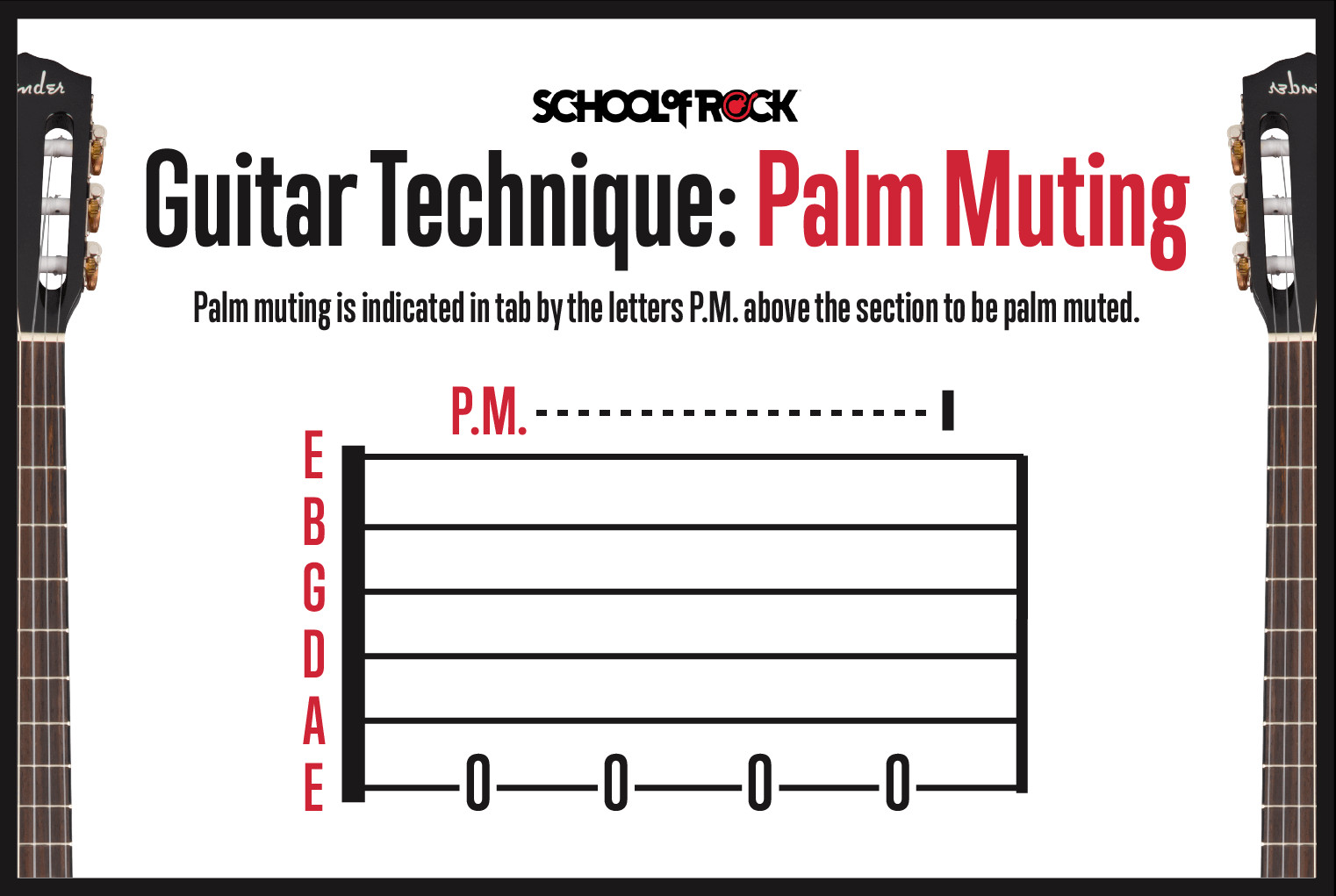 Guitar technique palm muting
Guitar technique palm muting
Alt text: Illustration of palm muting technique on guitar, showing the picking hand’s palm lightly resting on the strings near the bridge.
Guitar Technique: Muted Notes (X)
Muted notes are a different technique from palm muting and are performed using your fretting hand. In the tab, muted notes are still shown on the string lines and are meant to be picked, but they don’t produce a clear pitch because the fretting hand lightly touches the strings without pressing them down fully onto the fretboard. In guitar tablature, muted notes are represented by an “X” in place of a fret number.
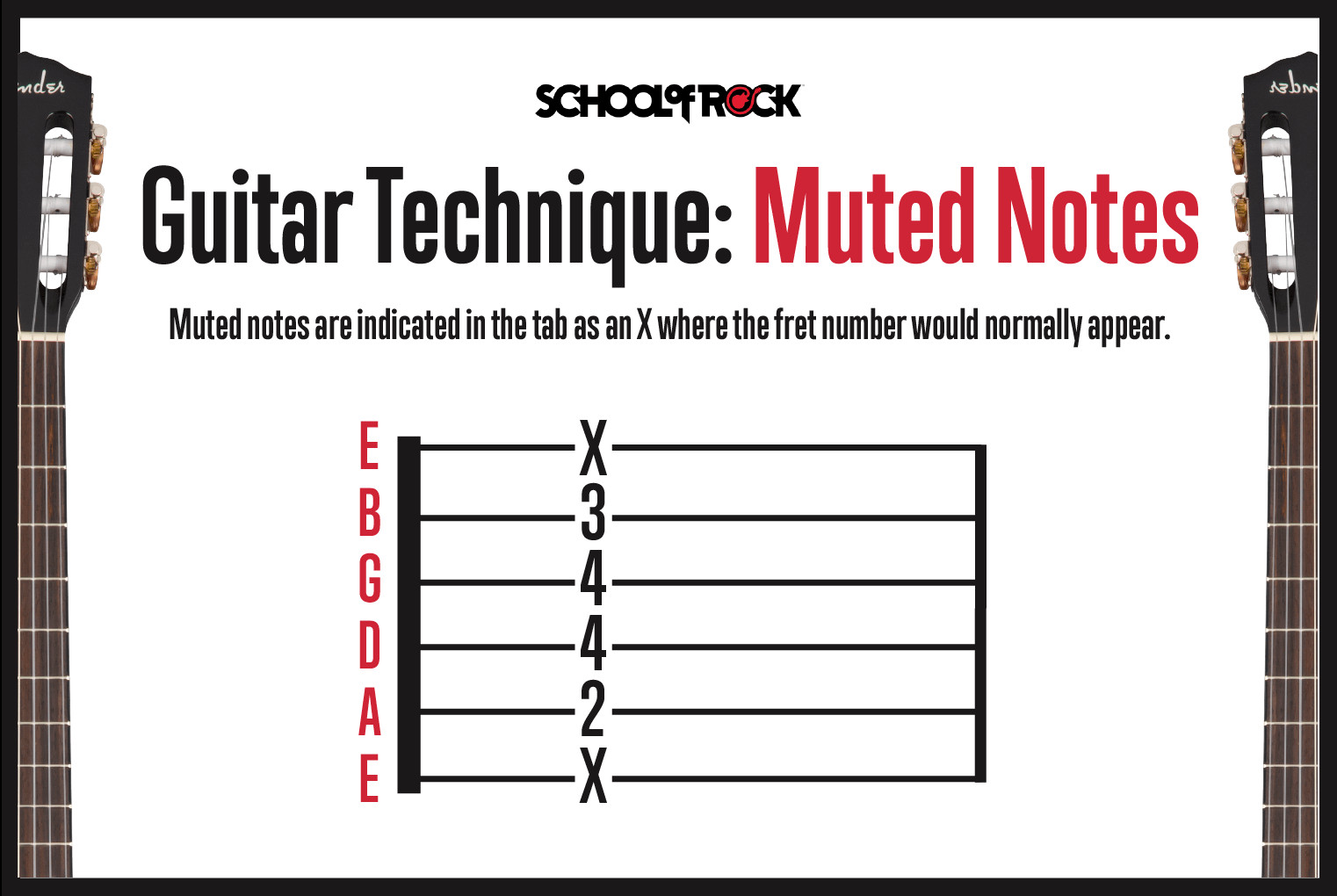 Guitar technique muted notes
Guitar technique muted notes
Alt text: Diagram showing muted notes technique, with an ‘X’ symbol in guitar tabs indicating a string should be muted by the fretting hand.
Bending Guitar Strings (Curved Arrow)
String bending is a technique that adds expressive, vocal-like qualities to guitar playing. In guitar tabs, bends are indicated by a curved arrow above the note to be bent. This arrow signifies that you should manipulate the string to raise its pitch. The arrow may also specify the amount of the bend, such as “½” for a half step bend (one fret higher) or “full” for a full step bend (two frets higher). These target pitches are often referred to as “target notes.”
How to Bend Guitar Strings
Bending involves pushing or pulling the string up or down the fretboard, rather than pressing straight down as you normally would. For most strings except the low E, you typically push the string upwards towards the ceiling. The low E string is usually bent downwards, towards the floor. The key to a good bend is applying smooth, consistent pressure throughout the bend.
Guitar Technique: Bending Guitar Strings
Most string bends are performed using 2 or 3 fingers together: your primary fretting finger (often the ring finger) along with the middle and index fingers for added support and strength. This combined finger approach makes bending smoother, easier to control, and helps achieve accurate pitch.
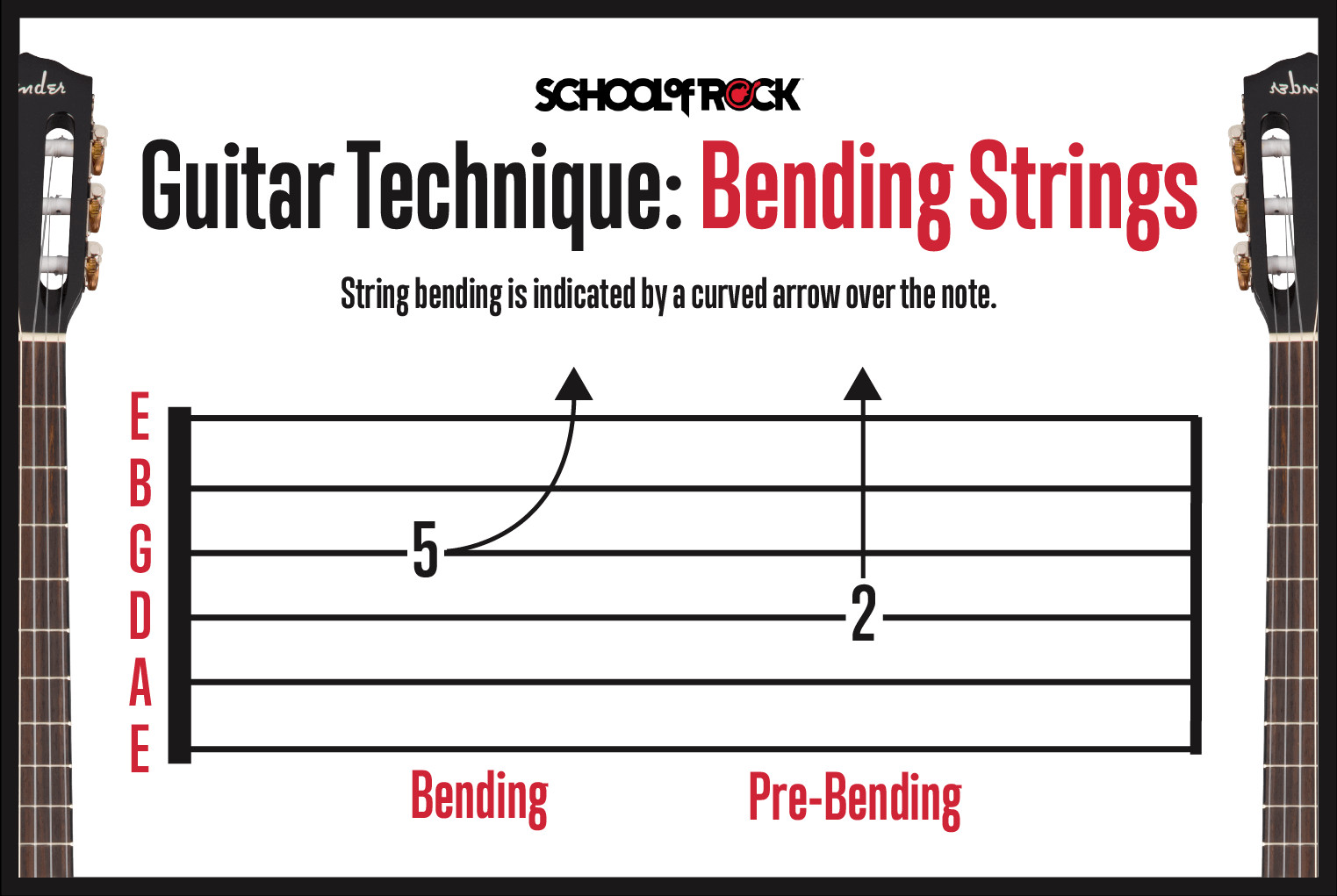 Guitar technique bending strings
Guitar technique bending strings
Alt text: Image demonstrating guitar string bending technique, showing finger placement and direction of bend on the fretboard.
Guitar Technique: Pre-bending Guitar Strings
When learning how to read guitar tabs sheet music, beginners might encounter “pre-bends.” A pre-bend involves bending the string to the target pitch before picking the note, and then either holding the bend or releasing it back to the original pitch after picking. In tab notation, a pre-bend is shown by an upward pointing arrow indicating the bend amount (full, ½, etc.), followed by a curved arrow pointing downwards if the bend is to be released. Pre-bent notes can return to their original pitch or be further bent to another target note.
Sliding Guitar Notes (Lines)
Sliding is another effective technique for smoothly transitioning between notes. You can slide up to a higher note or down to a lower note. Unlike bending, sliding involves moving your fretting finger along the fretboard to the next desired fret without lifting it from the string.
Guitar Technique: Slide Up (Upward line)
A slide up in guitar tabs is represented by a line connecting the note you are sliding from to the note you are sliding to. If the target note is higher in pitch, the line will often slant slightly upwards.
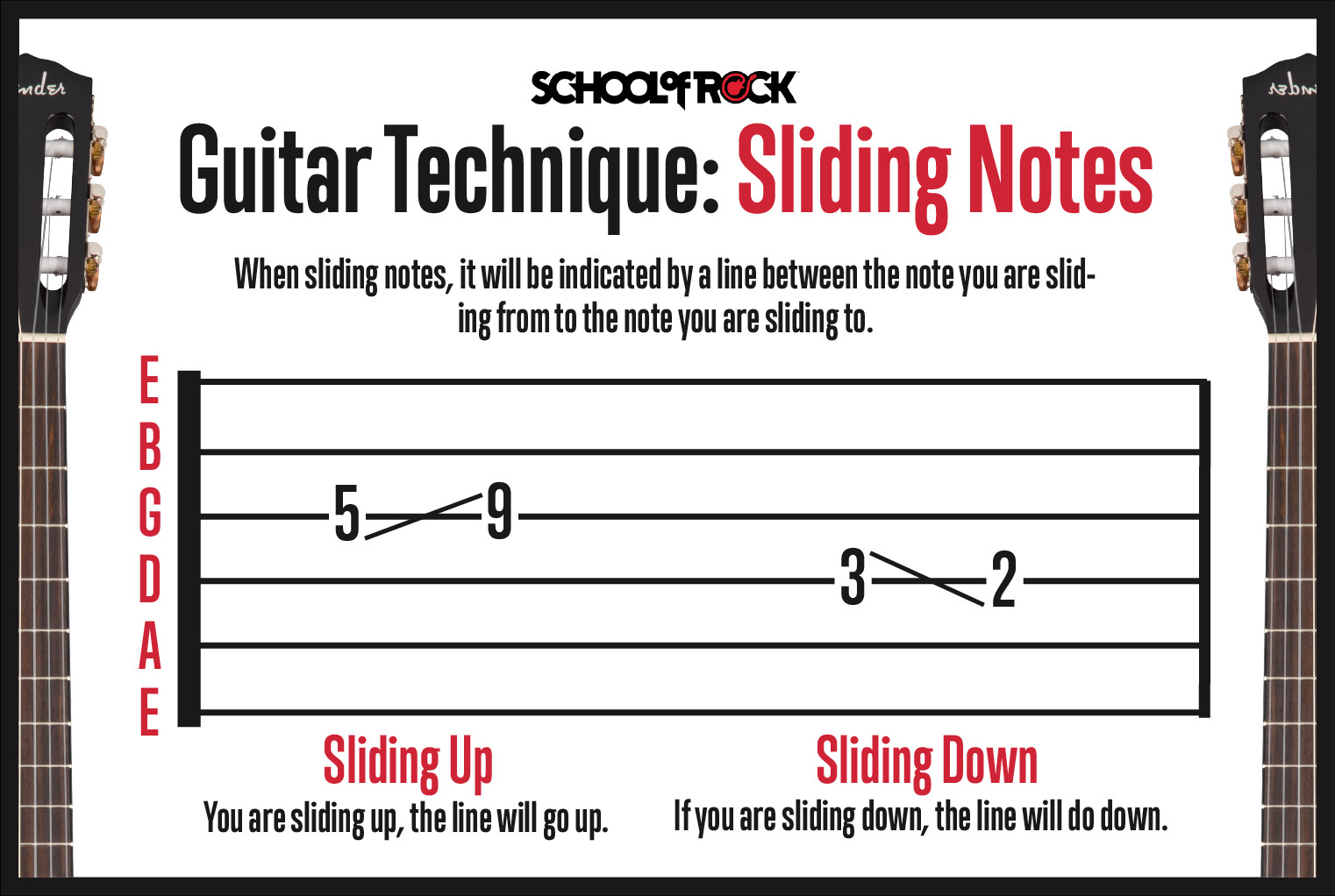 Guitar technique sliding notes
Guitar technique sliding notes
Alt text: Example of guitar slide technique notation in tabs, with a line connecting two fret numbers to indicate a slide between notes.
Guitar Technique: Slide Down (Downward line)
Conversely, a slide down is also shown by a line connecting two notes. If the target note is lower in pitch, the line may slant slightly downwards in the tab.
Playing Hammer-ons on the Guitar (H)
The hammer-on is a cool guitar technique where you produce a note by “hammering on” to a fret with your fretting finger, without picking the string again. You can hammer-on from an open string or from a previously fretted note, and the resulting note will always be higher in pitch. In guitar tabs, hammer-ons are indicated by the letter “H” and an arc connecting either an open string (0) to the hammered-on fret, or connecting two fretted notes.
How to Play Hammer-ons on the Guitar
To execute a hammer-on, strike the string sharply onto the fretboard with your fretting finger, using enough force to make the note sound clearly. This may take a little practice to get a strong, clean note. It’s often easier to perform on an electric guitar with some volume. Start by trying a hammer-on from an open low E string to the third fret. Hold the note to let it ring, and repeat on different strings and frets.
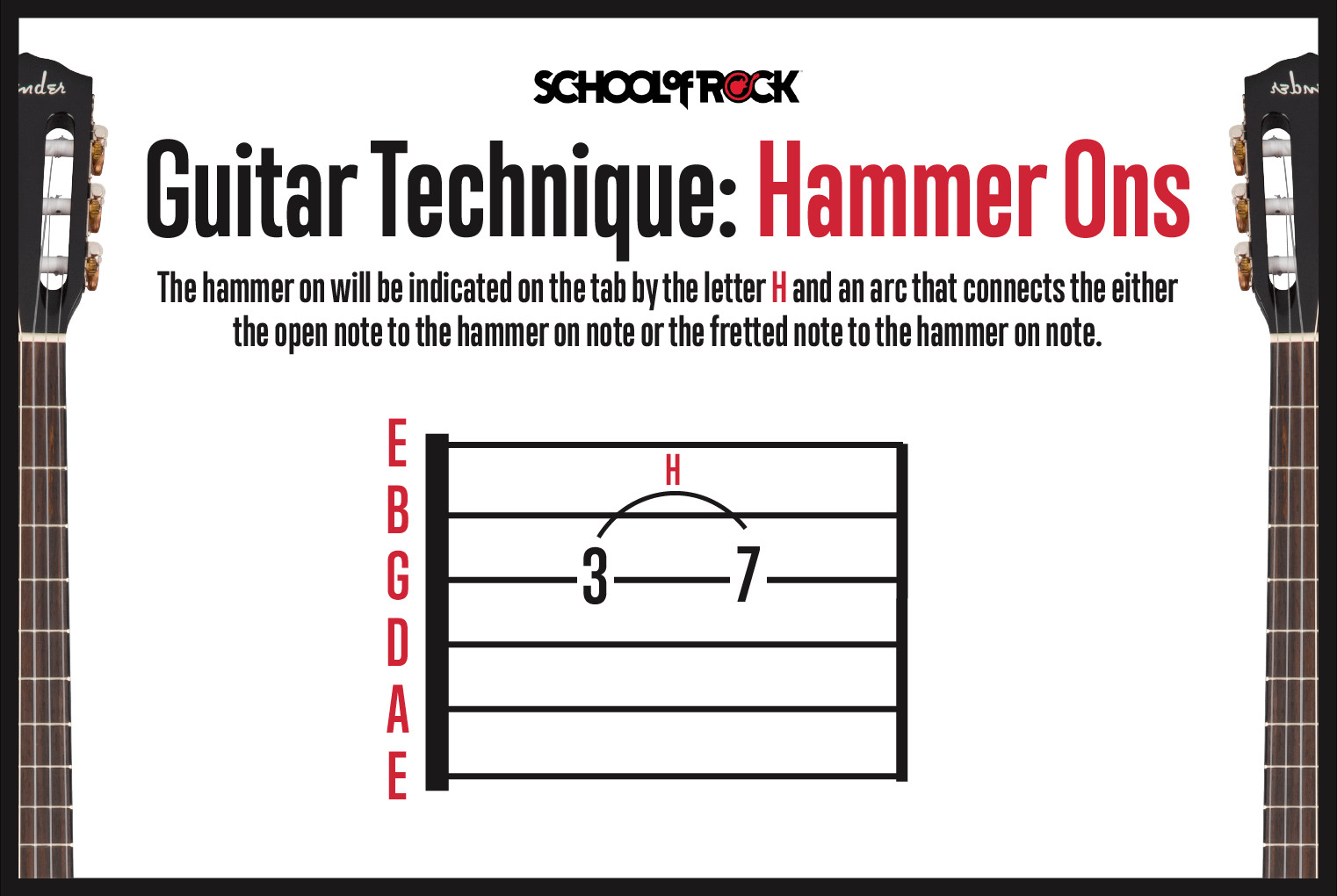 Guitar technique hammer ons
Guitar technique hammer ons
Alt text: Diagram illustrating hammer-on technique in guitar tabs, showing an arc and ‘H’ symbol connecting two fret numbers.
Playing Pull-offs on the Guitar (P)
Pull-offs are the opposite of hammer-ons. Instead of striking the string onto the fretboard, you “pull off” a fretted finger to sound either an open string or a note fretted by another finger. Pull-offs result in a lower-pitched note. In guitar tabs, they are shown with the letter “P” and an arc connecting the pulled-off note to the resulting open or fretted note.
How to Play Pull-offs on the Guitar
To perform a pull-off, fret a note, then pull your finger off the string in a sideways or downward motion, plucking the string as you remove your finger. This action causes the string to vibrate and sound the next note (either open or fretted by another finger). When playing pull-offs, ensure you “grab” enough of the string with your fingertip to produce a clear sound.
Hammer-ons and pull-offs can be combined in alternating sequences, creating a fluid and rapid series of notes. This combination is sometimes referred to as a “trill.”
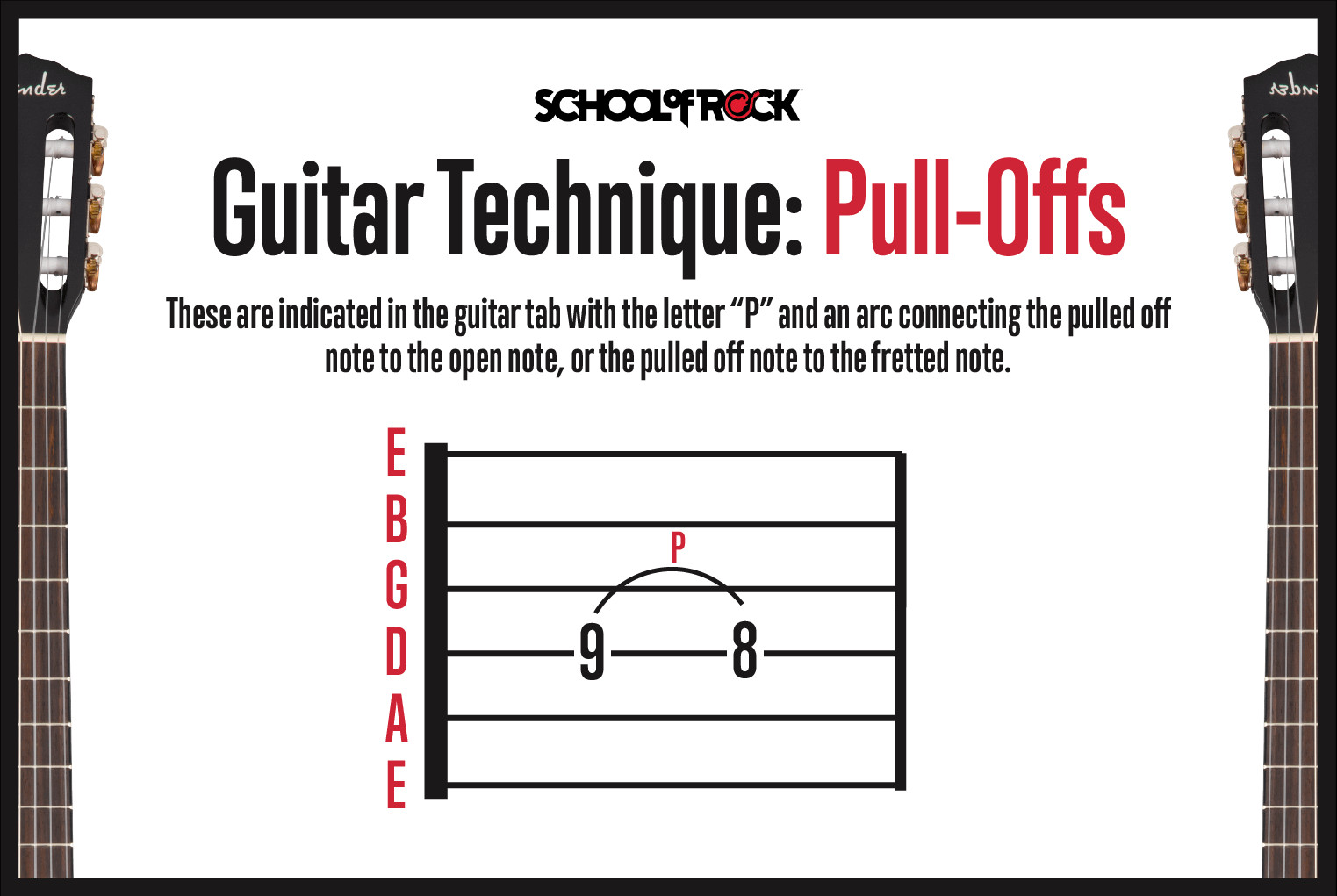 Guitar technique pull offs
Guitar technique pull offs
Alt text: Example of pull-off technique notation in guitar tabs, with an arc and ‘P’ symbol indicating a finger pull-off between frets.
Playing Vibrato on the Guitar (Zig-zag line)
Vibrato is a technique that adds warmth and expressiveness to sustained notes. It involves repeatedly and subtly bending a note up and down in pitch without fully releasing it. Vibrato is visually represented in guitar tabs by a zig-zag line above the staff. When learning how to read guitar tabs sheet music, pay attention to the length of the zig-zag line, as it often indicates the duration for which vibrato should be applied. Generally, a longer zig-zag line means a longer vibrato.
How to Play Vibrato on the Guitar
Vibrato is similar to bending but with a smaller pitch variation and a rhythmic repetition. You can apply vibrato using a single finger or by supporting your main fretting finger with others. Start by practicing a smooth, slow vibrato, and then experiment with varying speeds to achieve different expressive effects. Like bending, vibrato adds a personal, vocal-like quality to solos, and each guitarist’s vibrato becomes a unique aspect of their playing style.
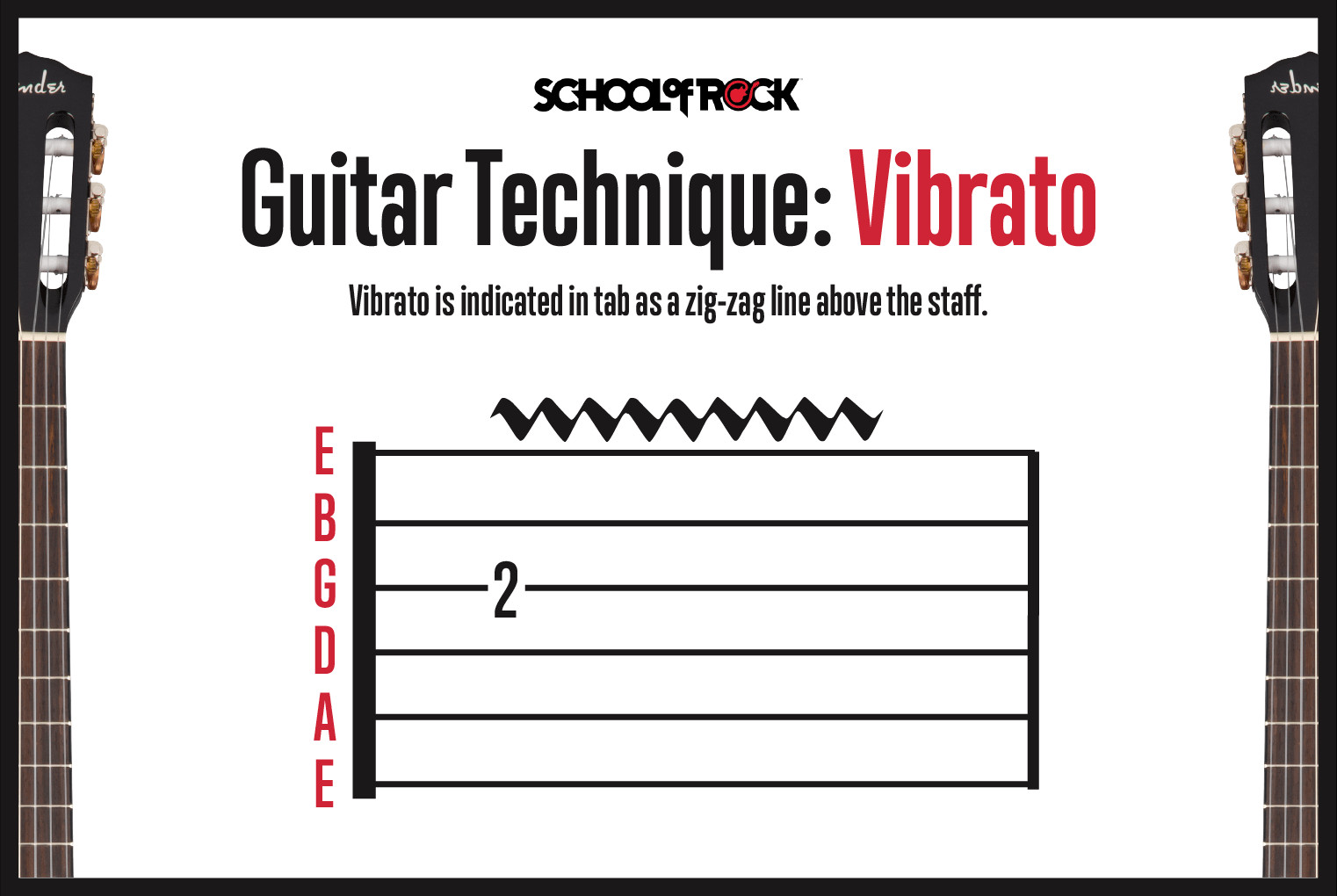 Guitar technique vibrato
Guitar technique vibrato
Alt text: Illustration of vibrato technique in guitar tabs, indicated by a zig-zag line above the note, representing a wavering pitch.
Tapping Guitar (T)
Tapping is a popular and virtuosic technique that involves using both hands on the fretboard to play notes. You fret notes with your regular fretting hand and also “tap” or fret notes with a finger from your picking hand, usually the index finger. The tapping action is essentially a variation of a hammer-on, but performed with the picking hand. In guitar tabs, tapping is notated by the letter “T” above the tapped note.
How to Finger Tap Guitar
Tapping was popularized by Eddie Van Halen, though the technique has roots in classical guitar. To finger tap, fret a note with your fretting hand as a starting point. Then, use the index finger of your picking hand to sharply tap a higher fret on the same string. The tap acts like a hammer-on from your picking hand.
Tapping allows you to play notes with intervals wider than you could reach using just your fretting hand, and it enables very fast playing since both hands are actively fretting notes. Playing with overdrive or distortion on an electric guitar enhances the sound and sustain of tapped notes.
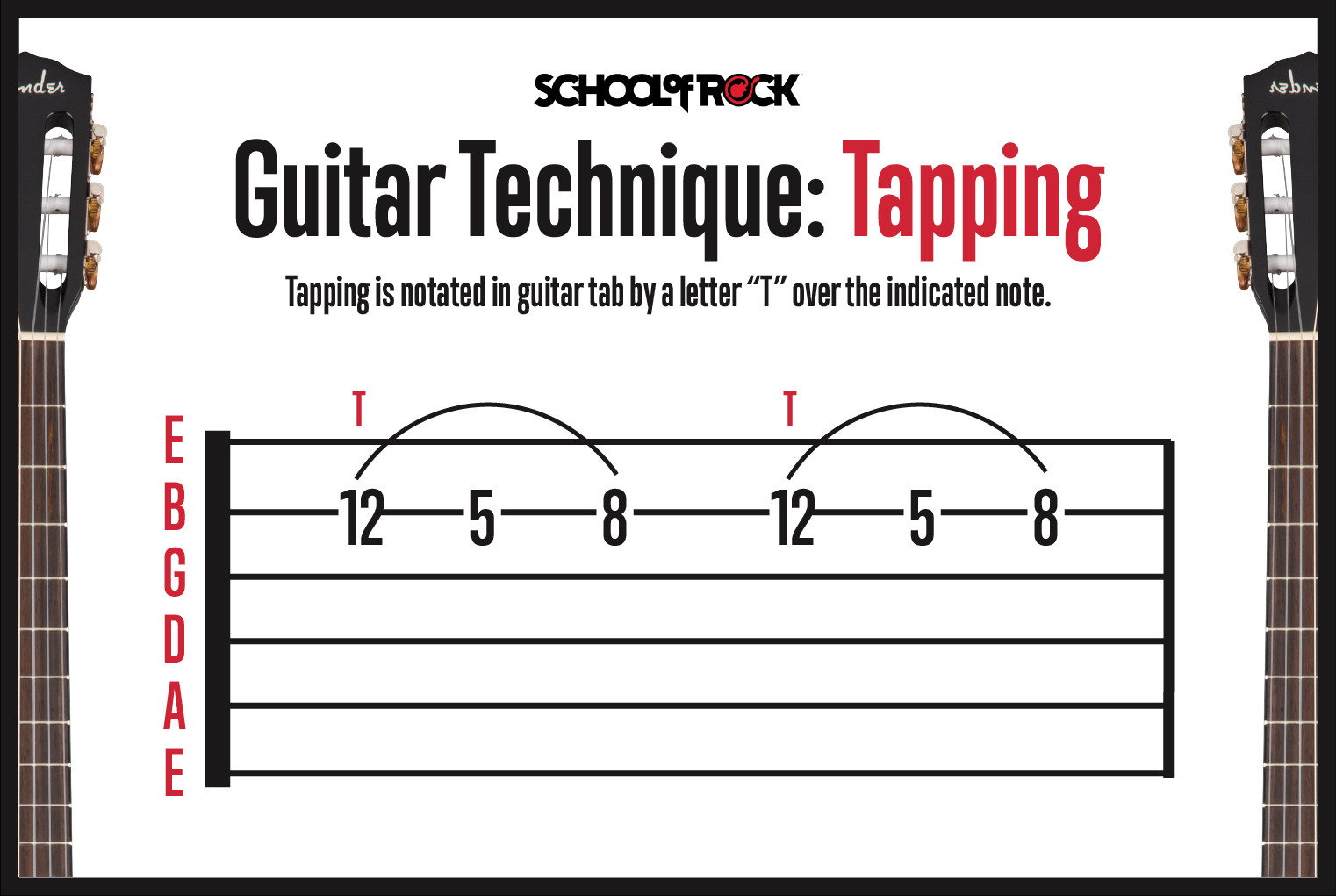 Guitar technique tapping notes
Guitar technique tapping notes
Alt text: Diagram of guitar tapping technique notation, with a ‘T’ symbol above fret numbers to indicate tapping with the picking hand.
Guitar Technique: Two-Handed Tapping
Two-handed tapping takes the technique further, involving both the fretting and picking hands independently tapping notes, often without any traditional picking. In this advanced technique, both hands essentially perform hammer-ons. Sometimes, the fretting hand taps bass notes while the picking hand simultaneously taps melody or solo lines, creating complex textures.
Strumming Guitar Notes (Downstroke/Upstroke symbols)
When strumming chords on guitar, there are two fundamental strumming directions: downstrokes and upstrokes.
Downstrokes are performed by moving your pick or strumming hand downwards across the strings, typically starting from the lower-pitched strings (closer to the floor) to the higher-pitched strings. In guitar tabs, downstrokes are symbolized by a thick horizontal line with two short “legs” pointing downwards on either side of the line.
Upstrokes are the opposite, performed by moving your pick or strumming hand upwards, from the higher-pitched strings to the lower-pitched strings. In guitar tablature, upstrokes are notated by a “V” shaped symbol.
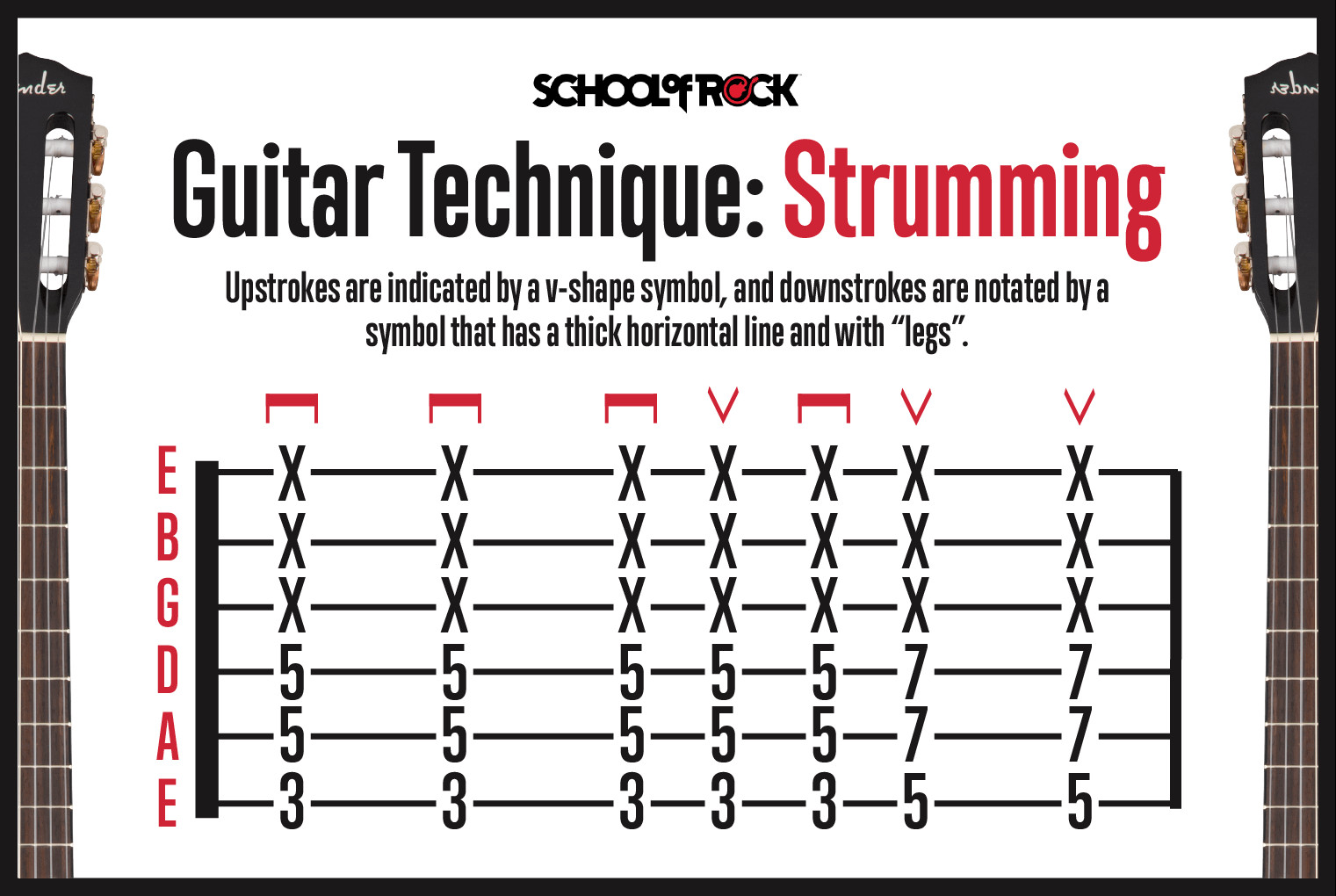 Guitar technique strumming
Guitar technique strumming
Alt text: Illustration of strumming notation in guitar tabs, showing downstroke and upstroke symbols and their directions across guitar strings.
How to Strum Guitar Notes
Strumming patterns in guitar music are diverse and depend on the rhythm and style of the song. You can strum using a constant down-up pattern, or various combinations of downstrokes and upstrokes to create different rhythmic feels. For rhythms based on eighth notes (counted as “1 and 2 and 3 and 4 and…”), many songs utilize alternating downstrokes and upstrokes, with downstrokes falling on the numbered beats (1, 2, 3, 4) and upstrokes on the “ands.”
Guitar Technique: Playing Downstrokes and Upstrokes
The downstroke and upstroke notation in guitar tabs isn’t just for chords; it also applies to single notes. When you see the downstroke symbol above a single note, it indicates picking that note with a downward motion of your pick. Conversely, the upstroke symbol above a note signifies picking it with an upward motion.
Ready to Learn Other Guitar Techniques?
Now that you’ve grasped the fundamentals of how to read guitar tabs sheet music and explored various guitar techniques, you’re well-equipped to start playing! From basic strumming to advanced tapping, guitarplayers.net is dedicated to helping guitarists of all levels reach their full potential. Our resources and guides cover a wide range of techniques, ensuring you can learn to play your favorite songs and styles.
Ready to find guitar tabs? Whether you’re looking for easy songs to begin with or challenging pieces to push your skills, guitarplayers.net is here to support your musical journey. Explore our curated collections of guitar tabs and sheet music to find your next song to learn!
Thinking about getting a new guitar? Check out our comprehensive Guitar Buying Guide for expert advice on choosing the perfect instrument to fuel your musical passion!


